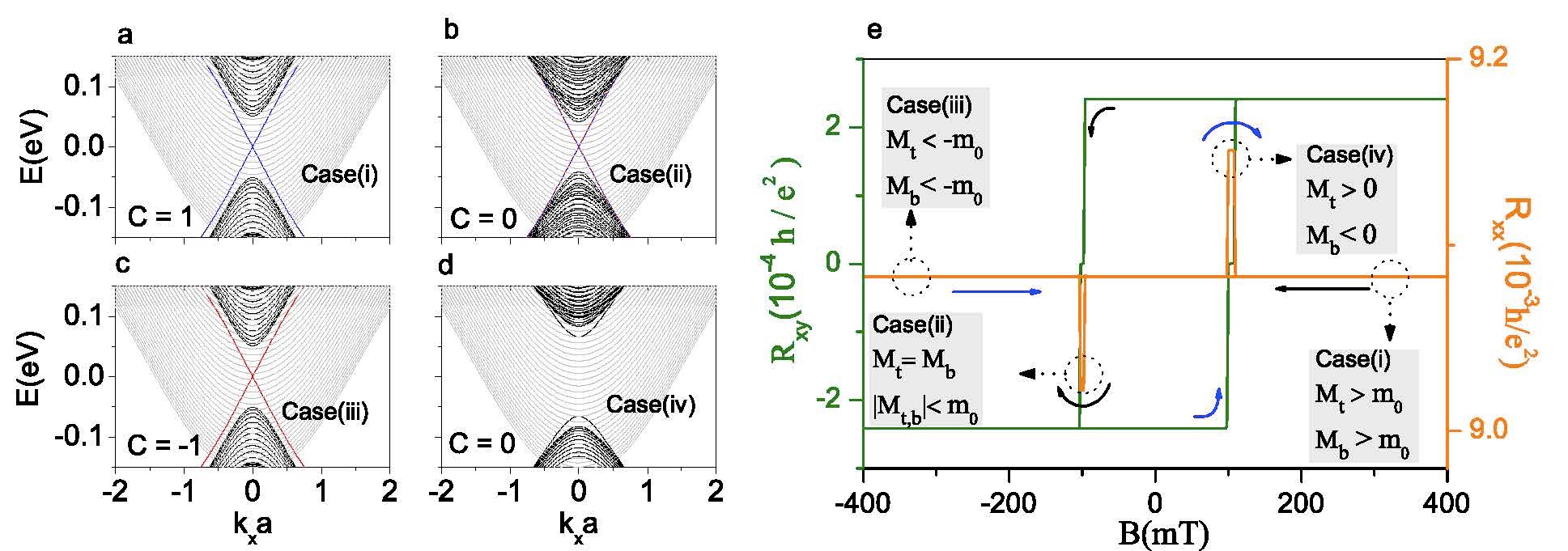Physical Review Letters reports Prof Qing Lin He et al.’s study on topological transition in topological insulator
Currently there is immense interest in the manipulation of ferromagnetic phases in topological insulators (TIs) through either doping with magnetic elements or proximity coupling to a strong ferromagnetic system. This interest is driven by the novel physics which is a consequence of the non-trivial topology in k space. Breaking time-reversal symmetry in these systems with magnetic dopants opens an exchange band gap, inducing a finite Berry curvature and leading to an intrinsic anomalous Hall effect (AHE). Inside this exchange gap, non-zero Chern numbers (C) of ±1 arise, protecting a chiral edge mode. Other than doping, proximity coupling to ferromagnets is another common method to introduce ferromagnetic order in TIs. Besides ferromagnets, antiferromagnets (AFMs) have been recently shown by Prof Qing Lin He et al. to enhance the magnetic order of a Cr doped TI thin film through interfacial exchange coupling. AFMs have vanishingly small net magnetization and consequently neither produce stray fields nor affect the characterization of the TI layer. Therefore the magnetic order is robust against the external magnetic field or moderate current perturbations, minimizing the crosstalk between devices and improving the scalability.
Recently, Prof Qing Lin He in ICQM – Peking University and his collaborators reported an experimental observation of the topological transition in thin-film topological insulator. By using antiferromagnetism, the surface magnetizations in both surfaces of the TI can be independently controlled. As shown in Figs. a and c, when the top and bottom surface magnetizations, M_T and M_B, have the same sign and are larger than the hybridization gap m_0 (Cases i and iii), Chern number of the system is C =±1, and chiral edge modes are therefore introduced. The magnetic TI thin film Hamiltonian can describe a quantum-anomalous-Hall (QAH) phase with C =±1 counting the number of topologically protected edge modes. On the other hand, during the reversal of the magnetization, unsynchronized switching may occur, inducing intermediate magnetic configurations without edge modes. When M_T > 0 and M_B < 0, the edge modes are gapped out due to the breaking of both time-reversal symmetry and inversion symmetry (Case iv), and an insulating phase is therefore obtained (Fig. d). Interestingly, during the reversal of the magnetization, an intermediate magnetic configuration can occur as shown by Case (ii). In this case, the C = 0 Chern number can possess counter-propagating edge modes induced by a restored inversion symmetry when both M_T = M_B and |M_T,B| < m_0 are satisfied in a transient spin configuration. The energy spectrum of this special case is depicted in Fig. b. It is important to note that the different M_T,B configurations can be detected by measuring the longitudinal (Rxx) and the Hall resistance (Rxy) as demonstrated in Fig. e, in which, Rxx and Rxy of the magnetic thin film and the AFM layers are calculated numerically using nonequilibrium Green's function techniques. Importantly, when M_T = M_B and |M_T,B| < m_0, two counter-propagating helical edge modes arise due to the restored inversion symmetry of the sandwich structure, and Rxx is therefore reduced (Case ii). On the other hand, when M_T and _MB have opposite signs, the edge channels are absent and Rxx is increased (Case iv). Due to the intrinsic asymmetry of M_T and M_B, we obtain antisymmetric magneto-resistance (Rxx) spikes during magnetization reversals as demonstrated in Fig. e. It is remarkable that the experimentally measured Rxx and Rxy can be well explained by the numerical simulations.
The above work was published on Physical Review Letters on Aug 29,2018. The link to this paper is: https://journals.aps.org/prl/abstract/10.1103/PhysRevLett.121.096802.
This work was studied by Prof Qing Lin He in ICQM, the group led by Prof Kang L Wang in UCLA, Dr. Alexander J. Grutter and Dr. Brian J. Kirby in NIST, the group led by Prof K. T. Law in HKUST, the group led by Prof Jing Xia in UC-Irvine, the group led by Prof Xiaodong Han in Beijing University of Technology, and Prof Roger K. Lake in UC-Riverside. Prof Qing Lin He, Dr. Gen Yin, and Luyan Yu are the first authors of the paper, while Prof Qing Lin He and Prof Kang L. Wang are the corresponding authors. This work is supported in part by the National Natural Science Foundation of China (Grant No. 11874070), the National Key R&D Program of China (Grant No. 2018YFA0305601).
Figure: a-d, The black solid lines show the energy spectrum of a TI thin film with different top-bottom spin configurations. The grey lines indicate the parabolic bands from the AFM layers. e, The evolution of the longitudinal resistance Rxx and the Hall resistance Rxy during the unsynchronized magnetic switching.
